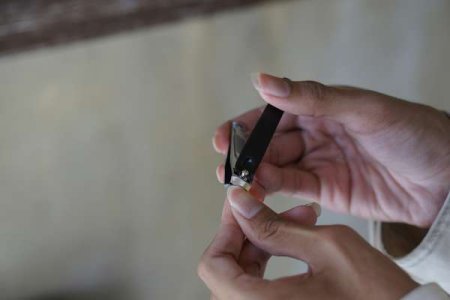Can your fingernails tell you how long you’ll live? Here’s what this top longevity doctor says about it.
- Replies 0
Disclaimer: The information provided in this article is for educational purposes only and is not intended as a substitute for professional medical advice, diagnosis, or treatment. Always consult your physician or other qualified healthcare providers with any questions you may have regarding a medical condition or before making any changes to your health regimen.
As we age, we often look for signs of our health and longevity in various aspects of our bodies, from the condition of our skin to the strength of our bones.
But have you ever considered that the secret to your lifespan might be right at your fingertips—quite literally?
The hands, often overlooked in health assessments, may hold surprising clues about our overall well-being and longevity.
According to Dr. David Sinclair, a renowned longevity expert and geneticist at Harvard Medical School, the rate at which your fingernails grow could be a window into your biological age and, potentially, your lifespan.
Dr. Sinclair, who hosts the podcast Lifespan, suggests that nail health is a key indicator of how efficiently our bodies generate new, healthy cells. “The rate of your nail growth is a really good indicator of how you're aging or not aging.”
Biological aging, which refers to how old the cells and tissues of the body appear, can differ significantly from chronological aging, which is simply the number of years you've lived.

The idea that fingernail growth could be linked to aging isn't new. Dr. Sinclair references a study from 1979 where scientists attached tiny measuring tapes to participants' fingernails and tracked their growth over time.
The findings showed that after the age of 30, the weekly growth rate of fingernails decreased by about 0.5 percent each year.
If your nails grow faster than this average, requiring more frequent trimming, it could indicate that you're aging more slowly than your peers.
Dr. Sinclair himself pays close attention to his own nail growth, using it as a personal barometer for his aging process.
Recommended for you: Discover the silent killers: A doctor exposes cancer signs everyone is missing!
“Every time I have to cut my nails, I'm thinking, how long ago did I cut my nails?” he says. This self-monitoring could be a simple yet effective way for individuals to gauge their biological aging.
Age can influence nail growth due to a decrease in blood circulation, which means fewer nutrients reach the nails to fuel their growth. Diet also plays a role as deficiencies in vitamins and minerals can slow nail growth.
Source: Gastrointestinal Society / Youtube.
Hormonal changes during puberty and pregnancy can cause spikes in nail growth, highlighting the complex relationship between our body's internal processes and nail health.
Beyond growth rate, the appearance of your fingernails can signal various health issues. Common signs of aging include nail ridges, which result from a slowdown in new cell production.
In younger individuals, these ridges could point to health conditions such as mumps, diabetes, or hyperparathyroidism, or deficiencies in vitamin A, zinc, calcium, or iron.
Changes to watch for include black spots, which could indicate melanoma or a wart under the nail bed, and white spots or lines, which may suggest a lack of zinc, calcium, or iron, or a fungal infection.
Source: Violin MD / Youtube.
Clubbing of the nails, where they widen and wrap around the fingertips, can be a symptom of serious health conditions related to low oxygen levels in the body's tissues.
While Dr. Sinclair is a respected authority in the field of genetics and aging, it's important to note that not all of his ventures have been without controversy.
Last year, he faced criticism for promoting a pill purported to reverse aging in dogs, which led to a series of resignations from the Academy for Health and Lifespan Research, an organization he founded. Despite this, his insights into biological aging remain influential.
Source: University of Arizona Health Sciences / Youtube.
Also read: Experts Reveal Shocking Health Secrets Hidden in Your Nails – Find Out Now!

Have you noticed changes in your nail growth or appearance? Do you have other methods of tracking your health as you age? Share your experiences and thoughts in the comments below!
As we age, we often look for signs of our health and longevity in various aspects of our bodies, from the condition of our skin to the strength of our bones.
But have you ever considered that the secret to your lifespan might be right at your fingertips—quite literally?
The hands, often overlooked in health assessments, may hold surprising clues about our overall well-being and longevity.
According to Dr. David Sinclair, a renowned longevity expert and geneticist at Harvard Medical School, the rate at which your fingernails grow could be a window into your biological age and, potentially, your lifespan.
Dr. Sinclair, who hosts the podcast Lifespan, suggests that nail health is a key indicator of how efficiently our bodies generate new, healthy cells. “The rate of your nail growth is a really good indicator of how you're aging or not aging.”
Biological aging, which refers to how old the cells and tissues of the body appear, can differ significantly from chronological aging, which is simply the number of years you've lived.

Dr. David Sinclair, a genetics expert from Harvard Medical School, suggests that the rate of fingernail growth can be an indicator of biological age and how we're aging. Image source: Yazid N. / Unsplash.
The idea that fingernail growth could be linked to aging isn't new. Dr. Sinclair references a study from 1979 where scientists attached tiny measuring tapes to participants' fingernails and tracked their growth over time.
The findings showed that after the age of 30, the weekly growth rate of fingernails decreased by about 0.5 percent each year.
If your nails grow faster than this average, requiring more frequent trimming, it could indicate that you're aging more slowly than your peers.
Dr. Sinclair himself pays close attention to his own nail growth, using it as a personal barometer for his aging process.
Recommended for you: Discover the silent killers: A doctor exposes cancer signs everyone is missing!
“Every time I have to cut my nails, I'm thinking, how long ago did I cut my nails?” he says. This self-monitoring could be a simple yet effective way for individuals to gauge their biological aging.
Age can influence nail growth due to a decrease in blood circulation, which means fewer nutrients reach the nails to fuel their growth. Diet also plays a role as deficiencies in vitamins and minerals can slow nail growth.
Source: Gastrointestinal Society / Youtube.
Hormonal changes during puberty and pregnancy can cause spikes in nail growth, highlighting the complex relationship between our body's internal processes and nail health.
Beyond growth rate, the appearance of your fingernails can signal various health issues. Common signs of aging include nail ridges, which result from a slowdown in new cell production.
In younger individuals, these ridges could point to health conditions such as mumps, diabetes, or hyperparathyroidism, or deficiencies in vitamin A, zinc, calcium, or iron.
Changes to watch for include black spots, which could indicate melanoma or a wart under the nail bed, and white spots or lines, which may suggest a lack of zinc, calcium, or iron, or a fungal infection.
Source: Violin MD / Youtube.
Clubbing of the nails, where they widen and wrap around the fingertips, can be a symptom of serious health conditions related to low oxygen levels in the body's tissues.
While Dr. Sinclair is a respected authority in the field of genetics and aging, it's important to note that not all of his ventures have been without controversy.
Last year, he faced criticism for promoting a pill purported to reverse aging in dogs, which led to a series of resignations from the Academy for Health and Lifespan Research, an organization he founded. Despite this, his insights into biological aging remain influential.
Source: University of Arizona Health Sciences / Youtube.
Also read: Experts Reveal Shocking Health Secrets Hidden in Your Nails – Find Out Now!
Key Takeaways
- Dr. David Sinclair, a genetics expert from Harvard Medical School, suggests that the rate of fingernail growth can be an indicator of biological age and how we're aging.
- A study from 1979 showed that the weekly growth rate of fingernails decreases as people age, starting from around the age of 30.
- Factors influencing nail growth include blood circulation, diet, and hormone levels, which can affect the supply of nutrients needed for nail growth.
- Changes in the appearance of fingernails, such as spots, lines, and ridges, can be signs of various health conditions, and it is important to take note of abnormal changes in shape or colour.
Have you noticed changes in your nail growth or appearance? Do you have other methods of tracking your health as you age? Share your experiences and thoughts in the comments below!
Last edited:






